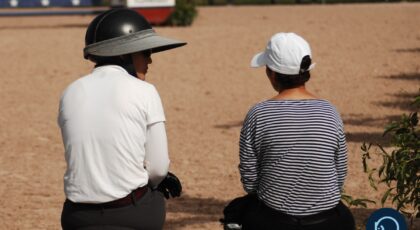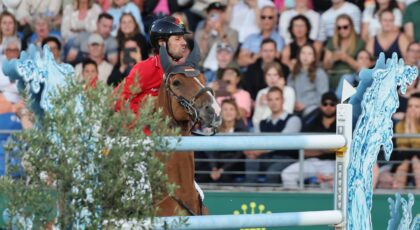You’re in the saddle for your daily hack, when you start to hear the grating noise of your horse grinding its teeth against the bit.
You try several times to change the rein pressure and alleviate the squeaking sound, but alas, the horse only begins to step shorter in its trot, and there is even a hint of aggression in his exhales. You transition down to a walk, but the grinding continues while your horse marches on for a lap.
What happened? You ask yourself. Why is my horse feeling anxious and frustrated?
One of the most important responsibilities of a rider or trainer is to recognize a horse’s limit.
This limit may change over time as the horse becomes stronger, more educated and more confident. Or, in the case of a horse of ten or more years, as it becomes older, weaker, stiffer and less agile. The limit of any horse is a moving target—and it must be respected.
A speed limit on the highway is enforced by the law. The performance limit of a horse is enforced by the consequence of going too far or, alternatively, not far enough.

Going too far
The consequences of exceeding the limit of the horse are long and often easy to spot. Many are not easy to fix.
1. The horse can lose confidence in his rider.
This can usually be fixed by changing the rider for one with a better instinct.
2. The horse can lose confidence in itself.
This is much harder to overcome and only time and positive experience will fix the loss.
3. The horse can resort to a poor or dangerous technique in order to do what is asked.
In fact, one of the important signs of asking too much is the loss of good technique. It is said by the old masters that a horse who repeats a bad technique three times will then be habitual in the error for his lifetime. This was said in the late 1600s pertaining to the flying change, but it is true today and it extends to jumping.
4. The horse can be injured physically.
Even if the horse does not stumble or fall, it is possible to twist or strain a muscle, ligament or tendon through severe effort. Time and a veterinarian with patience may rehabilitate the horse, but there is no returning to their original state.
5. The horse can learn defense tactics that become behavioral problems.
The defense will be according to the danger posed. Yet once a horse feels forced to protect itself, controlling the defense without eliminating the perceived danger will only produce a different, and often stronger, defense. All learned mechanisms remain embedded in the horse’s memory. This is one of the most serious consequences of all. A real professional must take over from a very low level to reprogram this behavior.
Signs that a horse is being asked beyond its level:
- Poor quality of movement or posture—impure gallop, hind legs apart at the trot, neck too short, nose behind the vertical or moving in a crooked way.
- Jumping in a poor technique, too quickly, not judging the height of the jump or twisting the shoulders left or right to avoid hitting the jump. Trajectory may not be well designed, with changes of speed or lead within the last strides.
- A lack of confidence, calmness, and concentration. Anxiety, hysteria and inattentiveness can indicate a horse is overmatched.
- Trying defense methods to eliminate the danger (stopping, running away, running sideways, going towards the exit, bucking, etc.) always indicates a horse beyond his limit.
Not going far enough
There is another limit to respect, which is rarely discussed: where the daily work is not challenging enough to be stimulating. This, too, is a moving target.
For a young horse, the intellectual challenge takes precedence over their physical condition and degree of fitness. If the proportion is off, the extremely fit, uneducated young horse becomes hard to control and requires a very physically strong rider. This is dangerous for the joints of the horse and also for the possibility of awakening the defense mechanisms previously discussed.
The measure of intellectual work alongside physical conditioning is correct when the horse begins the day with the idea of learning and working with the rider, not against.
Intellectual work with a young horse is tricky, because it must be within his capacity to understand. If the horse does not understand, and cannot find the solution within three or four minutes, the demand is beyond the intellectual limit of the horse—or is or poorly presented.
Repetition is not education.
Education requires new material. A rider, or a trainer, of a young horse must possess a huge source of ideas to present to the horse—all of which are in the limit of a four year old both physically and mentally.
As part of condition, to develop a certain strength one repeats an effort. Yet, repetition is boring. It is useful in its place, but as a method of training, with no intellectual stimulation, there are consequences:
Just as a smart student in a slow class starts to daydream, write notes, or create mischief, a young horse trained by repetition will start to leave the trainer behind. Boredom is the consequence of riding below the level of the horse.

Signs that a horse is working at a level too low include:
- Boredom, absence of spark, inertia, dull eye and lack of brilliance are usually seen in horses below their level.
- Jumping too low, trajectories too short, jumping too flat or thinking too slowly are all results of not meeting a horse’s potential.
- The level of the horse must be accurately analyzed. Working at a level too high is as detrimental as working at a level that is too low.
The older horse
It’s often said that a horse has a limited number of jumps.
The length of an older horse’s career is determined by the work he’s asked to do. Senior horses must be kept supple, so the priority is conditioning.
But equally important is stimulation. An older horse must learn something every week. If they learn nothing, they become stale and slow thinking. A rider must possess a huge source of new ideas to present to an older horse to stimulate his mental capacity that are still physically within his reach.
Repetition is not new education. A rider must know more than the horse he or she rides. A trainer should know more than the horse he or she trains.
Recapitulation
In general, the younger riders need to be aware of the upper limit of their horse and know the signs indicating they are too close to it. Repeating the work at a level beyond the horse will never ensure that he attains the level. It is far more likely that he will suffer the consequences listed above.
The older riders should be aware of the consequences of riding at a level too low for their horse. Repetition of work at the low level will not preserve the horse, but in fact accelerate the aging process.
One must recognize the limit of the horse!


 September 28, 2022
September 28, 2022 

























